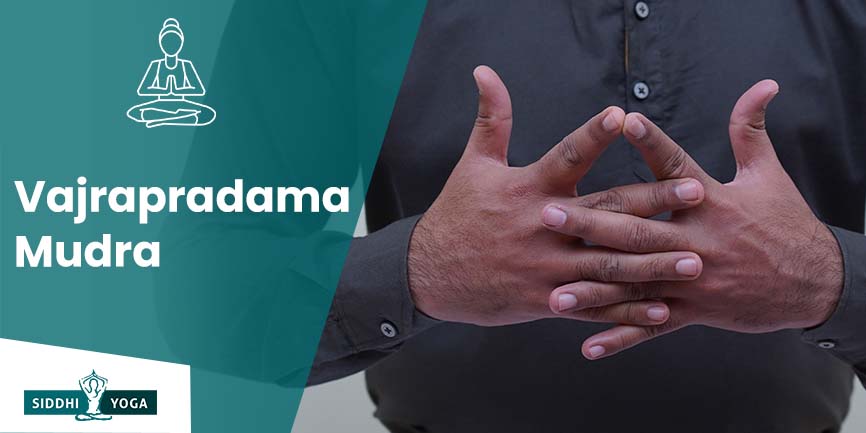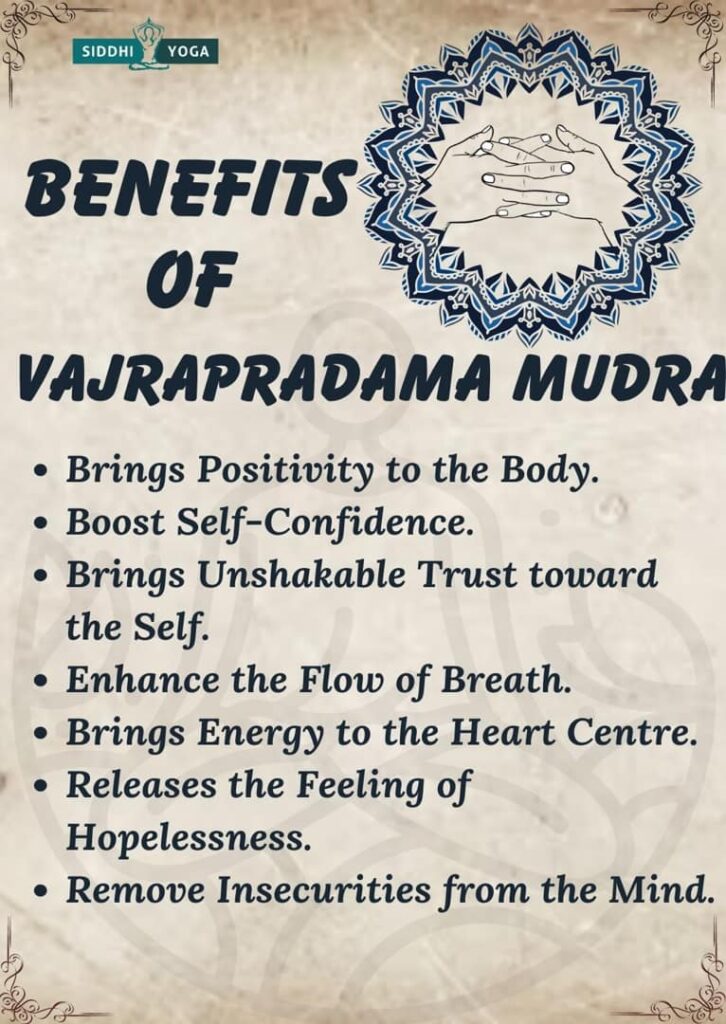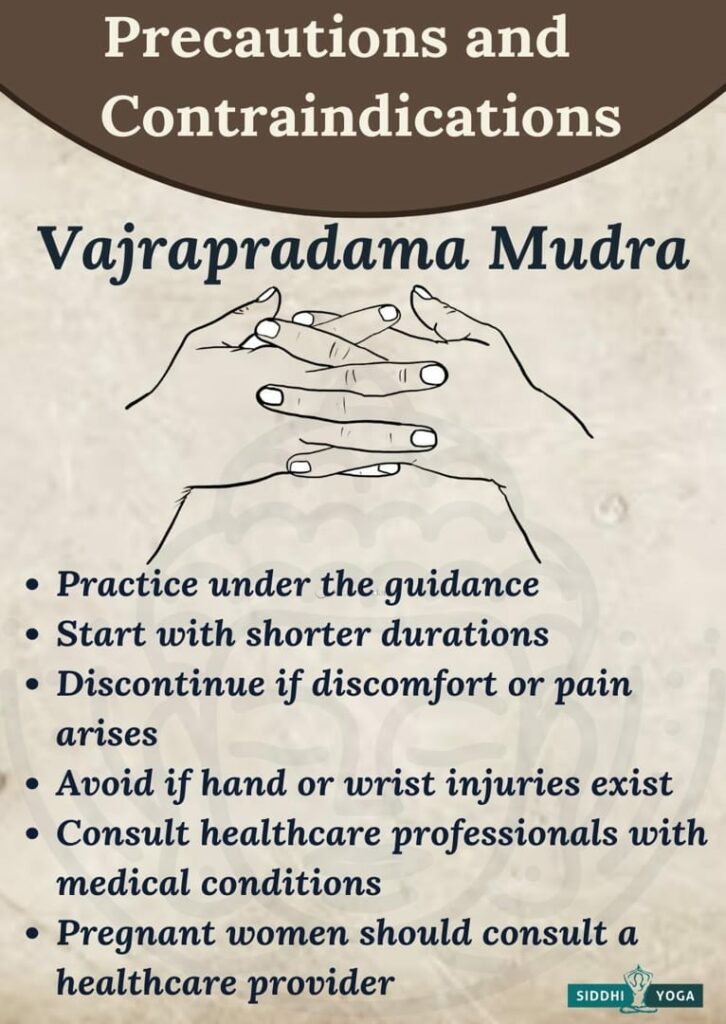Vajrapradama Mudra is one of the hand gestures/seals that help control energy flow through the body. Learn about the Vajrapradama mudra and its benefits, how to do it, and when to use it in your yoga practice.

Definition – What is Vajrapradama Mudra, and what are its Meaning, References, and Mythology?
To understand this Mudra better, let us break it down into two different words.
Vajrapradama – the Sanskrit word Vajrapradama is used to describe unshakable trust or unshakable confidence.
Mudra – Mudra is a word used to describe a hand gesture/seal.
Collectively this Mudra is often known as the Mudra of Unshakable Trust.
So, as its name suggests, practicing this Mudra will enhance your confidence and build self-trust within yourself. It releases reasons that cause mistrust. With more trust in yourself comes more confidence. With more confidence, you do better in your life. This Mudra is very beneficial for those who frequently have self-doubts. Self-doubt can shove a seed into the mind, harming our health. Self-doubts can even bring stress into your life because you feel like whatever you are doing in your life is not enough. You feel as if you are lacking something. And your thirst for more will never end this way, and this can bring unhappiness. If you practice this Mudra, you can become more aware of the fact that “You are enough.”
We realize that our inner strength is very much necessary. There are days when we face a situation where everything goes against what we have hoped for; in all those days, inner strength is required the most. Inner strength is essential for all age groups to win your day. Vajrapradama Mudra helps to build inner strength and boosts self-confidence. This Mudra also releases the feeling of hopelessness.
Alternate Names of Vajrapradama Mudra
Vajrapradama Mudra buddha, Unshakeable Trust Seal
How to do Vajrapradama Mudra?
- This Mudra can be practiced while holding different postures such as Vakrasana (Twisting Pose), Mastyendrasana (Lord of fishes pose), and other different postures if you are comfortable doing so.
- However, you can practice it while sitting in comfortable meditative postures (such as Sukhasana, Padmasana, or Swastikasana). Whichever posture you find comfortable while sitting is fine. Make sure you do not experience any backache.
- Keep your neck and spine comfortably erect.
- Rest both of your palms comfortably on your knee. Palms facing upward towards the sky.
- Gently close your eyes.
- Bring your palms together in Namaste or Anjali Mudra.
- Start to interlace your fingers and open up your palms so they can face your chest.
- Your thumbs should remain extended and should point upward toward the sky.
- Keep your elbows, wrists, and palms in the same line.
- Witness your inner self and your inner strength.
- Inhale slowly and exhale gently.
- You can practice it with different Pranayama and meditation techniques such as Surya Bhedan Pranayama (also known as right nostril breathing) and Kapalbhati Pranayama.
Vajrapradama Mudra Benefits

- It brings positivity to your body.
- It helps to boost self-confidence. Practicing this Mudra fuels up inner strength.
- This Mudra helps to clear the self-doubts and brings unshakable trust toward the self.
- This Mudra helps to release the feeling of hopelessness.
- It helps to fight all the insecurities that your mind carries with itself.
- It helps to enhance the flow of breath. So, you can practice thoracic breathing along with it. It will boost your self-confidence as well.
- It brings energy to the heart center.
Vajrapradama Mudra Precautions and Contraindications

Similar to all other Mudra practices, it has no side effects.
However, there are a few things to consider:
- Do not firmly press your finger against each other. They should be slightly touching each other and not put excessive pressure.
- Make sure to keep your thumbs extended.
- Keep your spine erect while ensuring you do not experience backaches.
When and How long to do Vajrapradama Mudra?
- This Mudra can be practiced when you feel that you lack self-confidence.
- You can practice this Mudra to attain the next level of self-love.
- This Mudra can be practiced if you experience self-doubts.
- You can practice it to release the feeling of hopelessness.
- You can practice this if you want to achieve a more significant state in meditation.
Morning is the ideal time to do any yoga or Mudra. In the morning, at this time during the daytime, our brain is at its best. So, you are more likely to be able to concentrate easily. Therefore, you should practice this Mudra from 4 am and 6 am to get the most effective outcomes.
If you are having difficulty with this during the morning, you can do this Mudra later in the evening too.
Practicing this Mudra for a minimum of 30-40 minutes daily is recommended. Whether you wish to complete it in one stretch or two threes that last between 10 and 15 minutes, it’s up to you. Based on research, the best way to practice an exercise for at least 20 minutes is to get the best benefits of that particular Mudra.
Breathing in Vajrapradama Mudra
There are various breathing types of breathing or Pranayamas that you can practice we can practice with this Mudra, but you can start with:
- Thoracic Breathing: As you inhale, let the chest expand to its maximum, and as you inhale, relax the chest comfortably, similar to a balloon. This will help to increase lung capacity.
Visualization in Vajrapradama Mudra
- Visualize and formulate unshakable trust within yourself.
- See things that you are better at.
- Observe the things that you do for yourself.
- Observe what small things you do to make yourself happy.
Affirmation in Vajrapradama Mudra
While practicing this, Keep a positive intention. Start with: I am happy because I trust myself. I am omnipresent for myself. I can count on myself.
Conclusion
The Vajrapradama mudra is a powerful gesture that can be used for healing, inner peace, and increased focus. If you are interested in learning more about this and other mudras, consider signing up for our Mudras Certification Course. This course includes 108 mudras, with detailed instructions on how to do them correctly.